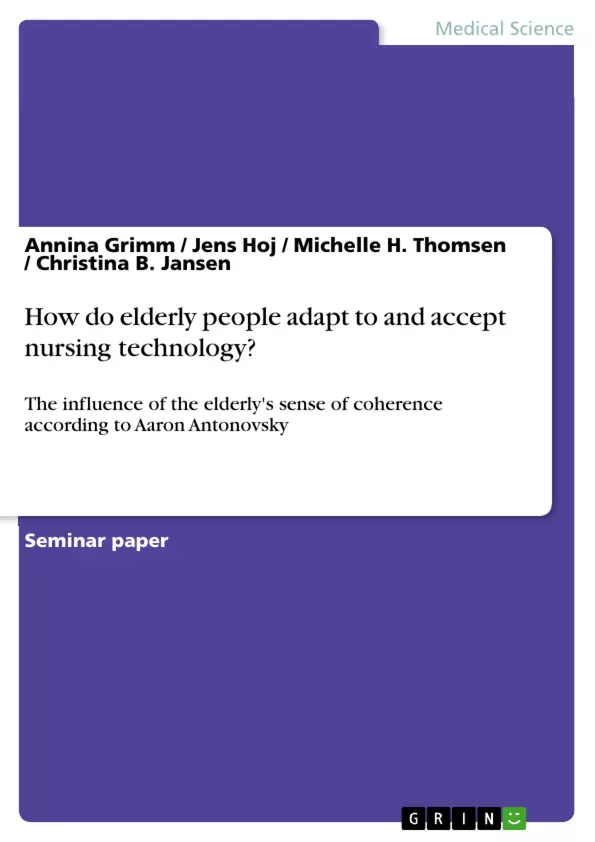The aim of this assignment is to find out if the elderly’s Sense of Coherence has an impact on the way they accept and adapt to nursing technology. The method that has been used consists of qualitative and quantitative research. The use of both methods helped to get a broader understanding of the technologies' impact on elderly people. A phenomenological hermeneutical method was used to understand and analyse the articles that were chosen. Aaron Antonovsky's theory Sense of Coherence gave the opportunity to find out how elderly people cope with the use of technology. Throughout the analysis four different articles are used to bring in different aspects on nursing technology, how the elderly adapt to technology and the importance of ethical aspects. The Sense of Coherence's effect on the adaption to nursing technology is illuminated. To draw a conclusion, nursing technology seems to be an ambivalent but effective tool in caring for elderly people. Health professionals and elderly people need education to handle the technology and to take advantage of the benefits. It is important for nurses to focus on the elderly’s Sense of Coherence to make it easier to accept and adopt to the technology. It is important for the nurse to take into consideration the ethical aspects of safety, dignity and rights of people when working with nursing technology. Furthermore the future development of nursing technology and its impact on nurses and elderly people are considered.
Inhaltsverzeichnis (Table of Contents)
- Summary
- Introduction
- Problem area
- Problem statement
- Purpose
- Key concepts
- Method
- Theory
- Literature
- Literature strategy
- Analysis
- Conclusion
- Perspective
Zielsetzung und Themenschwerpunkte (Objectives and Key Themes)
This assignment aims to examine the impact of the elderly's Sense of Coherence (SoC) on their acceptance and adaptation of nursing technology. It investigates how the elderly cope with and integrate new technologies into their daily lives, considering both the potential benefits and challenges associated with this process.
- The influence of the elderly's Sense of Coherence (SoC) on their acceptance and adaptation to nursing technology
- The impact of nursing technology on the elderly population, including both positive and negative aspects
- The role of nurses in supporting the elderly in navigating and utilizing nursing technology
- The ethical considerations surrounding the use of nursing technology in the care of the elderly
- The future implications of nursing technology for both nurses and the elderly
Zusammenfassung der Kapitel (Chapter Summaries)
- Summary: This chapter provides a concise overview of the assignment's purpose, methodology, and key findings. It highlights the importance of understanding the impact of the elderly's Sense of Coherence on their acceptance of nursing technology.
- Introduction: This chapter sets the context for the study by describing the increasing use of technology in nursing care and the growing need to understand the impact of these technologies on the elderly population. It raises questions about the elderly's ability to adapt and embrace new technologies in their homes and discusses the importance of understanding their experiences.
- Problem area: This chapter elaborates on the challenges faced by the healthcare system due to the global aging population. It discusses the potential benefits and risks associated with the use of nursing technology and highlights the need for further research in this area. It also explores the ethical considerations and the potential for technology to enhance or undermine human care.
- Problem statement: This chapter clearly defines the central research question of the assignment. It explores the relationship between the elderly's sense of coherence and their adaptation to nursing technology, considering the increasing prevalence of technology in healthcare.
- Purpose: This chapter explains the specific objectives of the assignment and outlines the intended audience. It emphasizes the importance of analyzing different articles and applying Antonovsky's theory of SoC to understand its impact on the adoption of nursing technology.
- Key concepts: This chapter defines key terms such as "nursing technology," "assistive technology," "telecare," "information and communication technology," "elderly people," and "Sense of Coherence." It provides a framework for understanding the different technologies and concepts discussed throughout the assignment.
- Method: This chapter details the research methodology employed in the assignment. It describes the literature search process, including databases used, search terms, and inclusion/exclusion criteria. It outlines the use of qualitative and quantitative research methods and the application of the phenomenological hermeneutical method for analysis.
- Theory: This chapter introduces Aaron Antonovsky's theory of Sense of Coherence (SoC) and its relevance to the study. It explains how SoC can be used to understand the elderly's coping strategies and their ability to adapt to new technologies. The chapter also discusses the importance of considering ethical aspects when discussing the use of nursing technology.
Schlüsselwörter (Keywords)
This assignment primarily focuses on the concepts of nursing technology, elderly individuals, Sense of Coherence, acceptance and adaptation, ethical considerations, and future implications of technology in healthcare. These key themes are explored through an examination of existing research on the impact of technology on the elderly population, with particular emphasis on the role of the elderly's sense of coherence in facilitating their successful integration of new technologies into their lives.
- Citar trabajo
- Annina Grimm (Autor), Jens Hoj (Autor), Michelle H. Thomsen (Autor), Christina B. Jansen (Autor), 2014, How do elderly people adapt to and accept nursing technology?, Múnich, GRIN Verlag, https://www.grin.com/document/287173



